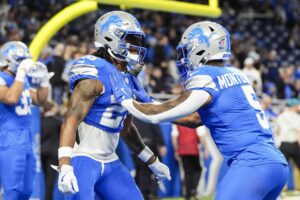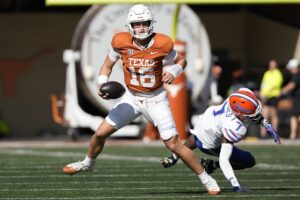Throughout NFL history, trades have been a common way to build a team. Trades can happen during the draft involving current or future draft choices. Trades can happen during the off-season or during the season. Some are small player-for-player swaps. Some are blockbuster deals that alter the course of franchises for years to come. Take the 1989 trade of Herschel Walker from the Dallas Cowboys to the Minnesota Vikings. It stagnated the Vikings for a few seasons while the Cowboys won three Super Bowls in four years. Trades can be a powerful force. But what about trading an entire NFL franchise? Believe it or not, it has happened twice in NFL history. The NFL only recognizes one such trade, but there is another unofficial one. With that, let’s explore the history of trading an NFL franchise.
A History of Trading an NFL Franchise
The Baltimore Colts for the Los Angeles Rams
Dan Reeves‘ Ownership of the Los Angeles Rams
Our story begins on April 15, 1971, with the passing of Los Angeles Rams owner Dan Reeves. Reeves had owned the team since 1941 when he paid $135,000 to purchase the then Cleveland Rams from their local ownership group. The Rams, at that time, were five years old and rather unsuccessful on the field to that point in time. Reeves slowly turned to the team around, winning the Western Division and the NFL Championship in 1945. One month later, Reeves announced he was moving the Rams to Los Angeles, the first major professional franchise on the West Coast.
In the 26 seasons in Los Angeles until Reeves’ death, the Rams suffered just eight losing seasons. The Rams made seven playoff appearances, won six division titles, made it to four NFL Championship Games and won the 1951 championship. From 1949 to 1951 they appeared in each championship game. The Rams were on the rise in the late 1960s when Reeves’ health began to decline. Reeves was diagnosed with Hodgkin’s lymphoma and passed away before the 1971 season.
Carroll Rosenbloom and the Baltimore Colts
During this time, one of the Rams’ chief division rivals were the Baltimore Colts, under the ownership of Carroll Rosenbloom. The Colts got their start following the failure of the Dallas Texans. The Texans ownership group returned the team to the league halfway through the 1952 season. Three years removed from losing the original Baltimore Colts, the City of Baltimore petitioned the NFL for a new team. Commissioner Bert Bell reached out to Rosenbloom whom Bell was confident had the financial backing and competitiveness to be successful. Reluctant at first, Rosenbloom eventually gathered a group of investors. Named principal owner, Rosenbloom’s new Baltimore Colts joined the NFL in 1953. Rosenbloom asked fans to give him five years to deliver a winning team.
Five years later, the Colts posted their first winning record. The next year they won the 1958 NFL Championship, defeating the New York Giants in “The Greatest Game Ever Played.” The Colts repeated as champions the following season as well. During Rosenbloom’s ownership, the Colts had four losing seasons. They made seven playoff appearances, reaching the NFL Championship Game three times and winning twice. With the advent of the Super Bowl, the Colts lost Super Bowl III but were victorious in Super Bowl V. However, despite these accomplishments Rosenbloom felt underappreciated by Baltimore fans and media. Rosenbloom wanted a new stadium, even if that meant leaving Baltimore. That was firmly rejected by other NFL owners and Commissioner Pete Rozelle.
Robert Irsay and the Trade with Carroll Rosenbloom
Following the 1971 season, the estate of Dan Reeves put the Rams up for sale. Future Tampa Bay Buccaneers found Hugh Culverhouse submitted a bid of $17 million for the Rams. However, at the last minute, Chicago-based industrialist Robert Irsay stepped in with a then NFL record $19 million bid for the Rams. On July 13, 1972, Irsay had purchased the Rams and would immediately be trading the NFL franchise to Rosenbloom for the Colts. All contracts and personnel would remain in place. Rosenbloom, ever the astute businessman, insisted on the trade rather than a sale to avoid paying $4.4 million in capital gains taxes. The remaining amount of $3 million paid by the NFL to the Baltimore Colts for moving to the AFC following the NFL-AFL merger would be paid to Irsay. Feeling his handshake agreement with the Reeves estate had been violated, Culverhouse sued the league.
With Rosenbloom’s aid, Culverhouse settled his lawsuit and received his franchise a few years later. The fortunes of the Colts and Rams went in very different directions. The Colts posted just three winning seasons and zero playoff victories while they remained in Baltimore. Citing similar concerns that Rosenbloom had regarding a stadium, Irsay finally moved the Colts out of Baltimore in the dead of night to Indianapolis in 1984. For Rosenbloom’s Rams, they won every West Division title from 1973 to 1979. Despite their dominance, the Rams lost in four conference championship games and lost their only Super Bowl appearance. Rosenbloom would drown in Miami on April 2, 1979. His wife Georgia Frontiere inherited 70 percent with his five children getting the remaining 30 percent.
The Philadelphia Eagles for the Pittsburgh Steelers
Dismal Beginnings
Now for the trade that did not officially happen as far as the NFL is concerned. This story begins in 1933 when the NFL added two new teams in Pennsylvania. Bert Bell and Lud Wray formed the Philadelphia Eagles on the east side of the state while Art Rooney set up the Pittsburgh Pirates on the west side. It was rough going for both franchises early on. In their first eight seasons, the Pirates won 23 games. The Eagles were even worse, winning 19 games in the same span. The Pirates had managed only one non-losing season and never finished higher than second in their division. The Eagles had eight straight losing seasons and never finished higher than third in the division.
The constant losing wore Rooney’s patience thin. Mounting losses and a possible player shortage led Rooney to believe it was time to cut bait and move on. Meanwhile, in Philadelphia, Bell had become the sole owner of the Eagles following a public auction in 1936. Bell and Rooney decided it would be better to work together rather than fail alone. In December 1940, Rooney sold the Pirates to New York businessman Alexis Thompson for $160,000.
Rooney Regret
Following the sale of the Pirates to Thompson, Rooney used that money to purchase 50% of the Philadelphia Eagles. Rooney, Bell, and Thompson then pooled their rosters together and conducted a mini-draft between the teams. In the end, eleven players went from Pittsburgh to Philadelphia with seven going the other way. By January 1941, Thompson also renamed the Pittsburgh Pirates to the Pittsburgh Iron Men. During those early months of 1941, Thompson discussed moving the Iron Men to Boston to have them closer to his home in New York. Rooney and Bell proposed renaming their team to the Pennsylvania Keystoners and playing half their games in Pittsburgh and Philadelphia if Thompson moved the Iron Men. The league’s other owners rejected both proposals.
When March 1941 rolled around, Rooney was having regret for abandoning the team he founded. Rooney was from Pittsburgh and had no intention of moving. Because Thompson had yet to set up an office for the Iron Men in Pittsburgh, Rooney made Thompson an offer. Rooney and Bell would trade “territories” with Thompson. Rooney and Bell would move their players, coaches, and corporate structure to Pittsburgh. In exchange, Thompson would take his to Philadelphia. The names, colors, and records of each team would stay in their respective cities with the new teams taking them up as their own.
Aftermath
The net result was Bert Bell sold the Philadelphia Eagles to Alexis Thompson and then purchased a 50% stake in the Pittsburgh Iron Men. Officially, according to the NFL, territorial rights cannot be traded. Because neither team missed games, nothing officially happened. With Art Rooney remaining as the owner of the Pittsburgh club, his family’s ownership of the team is seen as unbroken. There was still some evidence that the “trade” occurred for a few years. Before the start of the 1941 season, Rooney renamed the Iron Men to the Steelers. However, from 1941 until at least 1945, the Pittsburgh club’s corporate name was the “Philadelphia Eagles Football Club, Inc.” The NFL might not consider that as trading an NFL franchise, but it most certainly is.
Main Photo:
Embed from Getty Images






